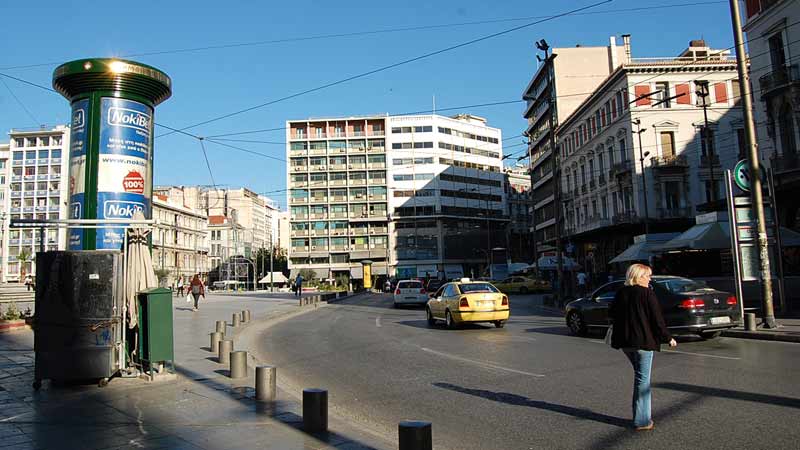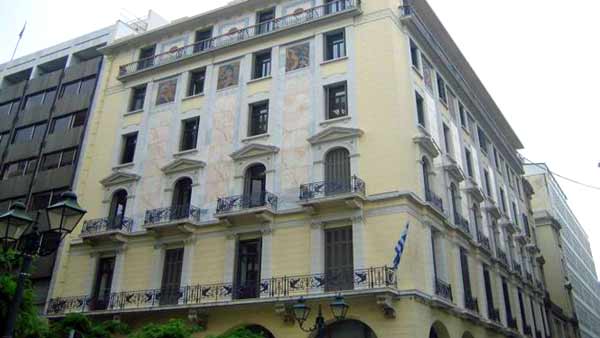A neoclassical walk back in King's Athens

A neoclassical walk back in King's Athens
Starting point: Omonoia Square
Ending point: Omonoia Square
Approach distance: 3 km
Ideal time: working day in the morning
◇ Omonoia Square

Our walking tour starts from the second largest square of Athens, Omonoia Square, which anyone can access via metro, bus and trolley, car or by taxi. When the architects Kleanthis and Schaubert prepared the first draft design of Athens in 1833, they placed the Palace of King Otto on Omonoia Square. From this plaza, the 5 important streets starts; Athinas Street, Pireos Avenue, Agiou Konstantinou Street, 3rd September Street, Akadimias Street and Stadiou Street.
◇ Bagkeion Hotel
As you start your walk from Omonoia Square, exactly on your left hand side, is the four-story "Bagkeion Hotel" (Omonia Square 18 & Athinas Street), which dominates the eastern corner of the intersection of Athinas Street with Omonoia Square. It was built in 4 years, from 1890 to 1894, based on plans of the architect Ernst Ziller. This was the house, where until 1883, the family of Charilaos Trikoupis lived. Trikoupis was former Prime Minister of Greece who declared Greece’s bankruptcy in the 10th of December 1983. Unlike the rest of the hotels of the district, which declined after the war, the "Bagkeion" showed a remarkable resilience, and operated until 1969.
◇ Hotel Alexander the Great
The 4-storey hotel "Alexander the Great" (Omonoia Square 19 & Athinas Street), which dominates the western corner of the intersection of Athinas Street with Omonoia Square, was built in 1889, based on the plans of the renounced architect Ernst Ziller. Its construction marked a new era for the Athenian hotels, in terms of size, internal layout and external form (characteristic decoration of the rooftop with crimson rectangular surfaces). A key new element is the central atrium, with glass being the dominant material.
△ Turn into Athinas Street
The city planners laid out Athinas Street in such a way that it would lead from the Omonoia Square to the entrance of the Acropolis (the decision that gave its name to the street, like an imaginary continuation of the Temple of Athena Nike on the Acropolis). But the initial project failed because it was considered extravagant. After the transfer of the capital from Nafplio to Athens, Athinas Street was a street-bazaar of goods arriving from the provinces or abroad, in order to provide with goods the citizens of the new capital. Traders houses were usually on the first floor of the buildings and their shops on the ground floor. Several wealthy merchants settled there, hiring famous architects to design and build majestic constructions - many of which have survived to this day.
◇ Civil Servants Share Fund Building

Keep walking straight down Athinas Street. Just 100 meters away from Omonoia square, on your left-hand side is the Civil Servants Share Fund Building. It stands at the corner of Athinas Street and Lyκourgou Street and was built in 1920, to host the Share Fund Policies Employees. Its renovation transformed it into a modern building so to create harmony between the new construction and its operational conditions, without however losing its classical aesthetic. The project is a formal display of "Hellenism" architecture with clay ornaments, colorful marbles, and mosaic representations of the Greek mythology.
◇ Athens Town Hall
110 meters from the Civil Servants Fund Building, on your right-hand side, there is one of the architectural jewels of the city; the Athens Town Hall (Athinas Street 61-63). It is on Athinas Street, right across from Kotzia Square (on your left-hand side). The design of the 2-story, stricty neoclassical building was directly influenced by the architecture of the palace, while its construction was completed in just 2 years.
◇ Kotzia Square
Right across from the Town Hall is Kotzia Square. This square has many names: Square Louis, People's Square, Post Office Square, Square of the Town Hall, Kotzia Square, and Square of National Resistance. In 1831 the plans of the area were extended so that it would reach Omonoia, to create "The Garden of the People".
◇ Mela Building
On the Square, there is also the Mela Building that you will find if you walk up Kotzia Square towards Sofokleous Street and Aiolou Street (which is the street above and parallel to Athinas Street). The 2-story building designed, once again, by Ernst Ziller, was built in 1874 and was the largest privately-owned structure of its kind in the city. The Mela Building was originally a hotel named "Grand Hotel d 'Athènes", to accommodate visitors from abroad. In 1881, it operated as Greece’s stock market and by 1979, it was leased so to house the Hellenic National Bank. Typical architectural features of the building are the 4 corners that resemble small towers, the elegant central atrium on the ground floor, the decorative caryatids, and the circular medallions with the head of Hermes (the messenger of the Olympian Gods).







